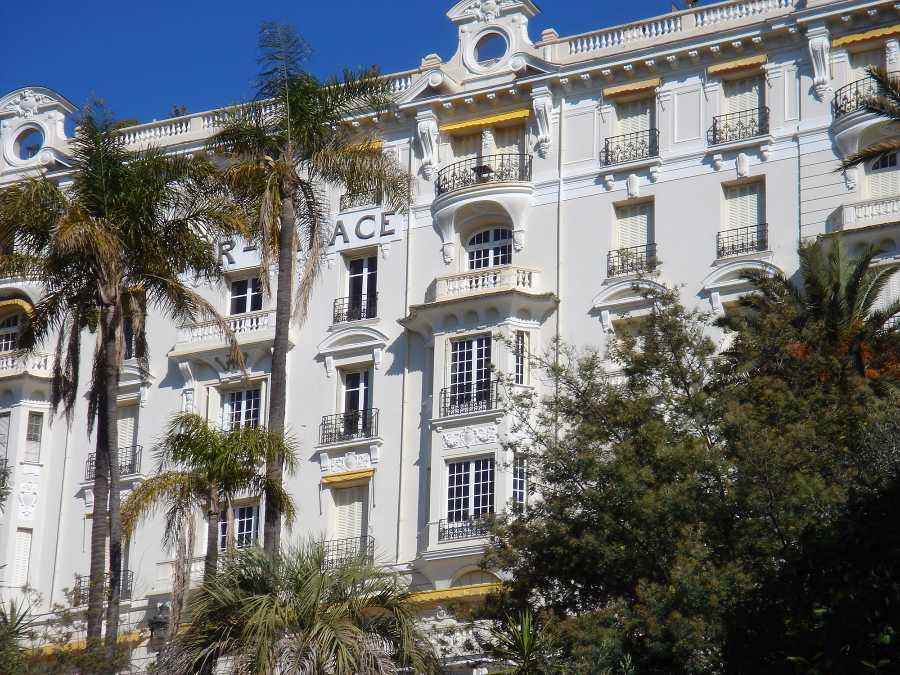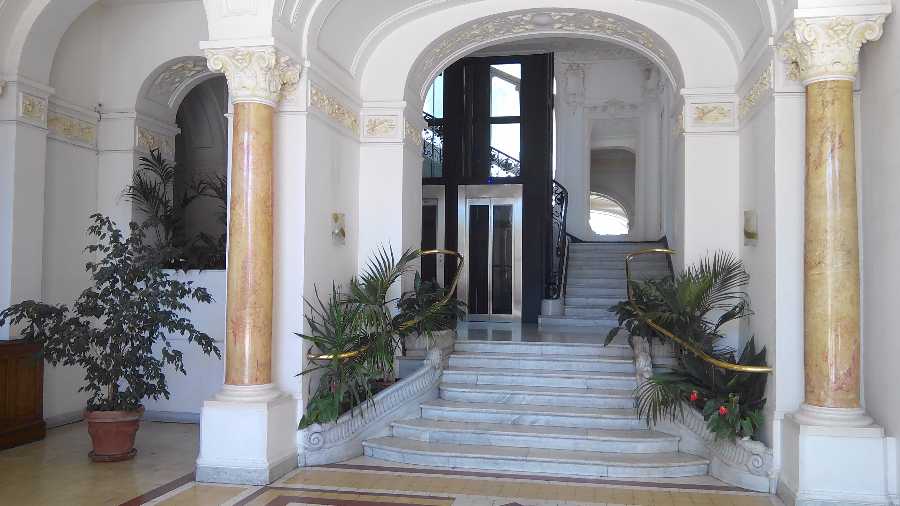– MENTON –
An “absolute marvel…”
Dominique FERNANDEZ *
(“Menton”, 2001, éditions Grasset)
Dominique FERNANDEZ *
(“Menton”, 2001, éditions Grasset)



The Winter Palace was catalogued on the French Supplementary Historic Monument List in 1975.
It was listed as a “20th Century Heritage Building » by the French Ministry of Culture and Communication in 2001.
The Winter Palace is a former hotel, located in Menton at n° 20 Avenue Riviera. It is surrounded by attractive landscaped gardens covering 1.87 hectares.
Construction began in 1901 under the direction of architect Joseph-Albert Tournaire** who was commissioned by the “Société Hôtelière de Isles Britanniques”. The hotel opened the 1st of january 1903.

Categorized as a “luxury hotel”, offering 220 rooms and suites, it was equipped with the latest “mod cons” of the time: garages, electricity, central heating, lifts, en-suite bathrooms and also a restaurant, smoking room, billiard room, library, card room, ladies’ salon, etc…
It had a permanent staff of over sixty to cater for guests who were often also accompanied by their own personal servants. A service entrance, staircase and luggage lift were reserved for staff so as not to disturb the guests.
When it opened, the hotel was a haven for mainly English and Russian members of the European aristocracy who preferred to spend the winter on the Mediterranean, often staying in the Winter Palace for several months at a time due to Menton’s mild and salutary climate which was reputed to be the best in Europe. These were the Palace’s halcyon years which came to an end with the outbreak of the First World War in 1914.


For the duration of the war, the Winter Palace was assigned to accommodate officers, which is why it was relatively well preserved in comparison to other hotels in Menton which underwent considerable alterations for use as military hospitals.
The hotel prospered once again during the roaring Twenties. However, in the late thirties it started to decline in the lead up to the Second World War.
It was commandeered first by the Italian army and later by the Germans. In September 1944, it served as the headquarters for the First Special Service Force, an elite American-Canadian commando unit, including the 2nd Canadian Battalion which was instrumental in the liberation of villages to the North of Menton.
After the war, the hotel never recovered economically. For a few years, it was home to the League of International Teaching. In 1958 it was sold through a promoter and converted into a private residence.


Nowadays the residence is comprised of a hundred apartments belonging to owners of diverse nationalities: mainly French, but also Italian, English, German, Belgian, Canadian, Swedish, Swiss, Portuguese etc.
The façade of the building “is a combination of the formal style of Louis XVI and Italian charm, almost as if the Hotel Crillon had been transported to the French Riviera and its features softened by the Ligurian environment *”.
The façade has been kept intact as has the entrance hall with its trompe l’oeil marble columns and the demi-rotunda with its partially glazed ceiling, which used to function as the smoking room.
In 1964, André Malraux initiated a general inventory of French cultural heritage which prompted the “Provence Alpes Côte d’Azur” Region to conduct a study of the coastal heritage of the Alpes Maritimes and the Var departments, concentrating on features which were “emblematic of the development of the French Riviera and the wealth of its achievements, of which the Winter Palace is one of the finest examples.” ***

* Dominique Fernandez, author, is a member of the French Academy, winner of the Prix Médicis in 1974 and the Prix Goncourt in 1982. He is one of the most respected specialists in Mediterranean Baroque style.
** Joseph-Albert Tournaire (1862-1958) was a renowned architect and winner of the Prix de Rome in 1888. He built the Villa Arnaga for Edmond Rostand at Cambo-les-Bains and he led the embellishment work on both the Villa Ephrussi at Saint Jean Cap Ferrat and the Palais de Justice in Paris. He was appointed head architect for the Colonial Exhibition in 1931
*** Head of the Cultural Heritage Service for the Provence Alpes Maritimes Côte d’Azur Region, 2016